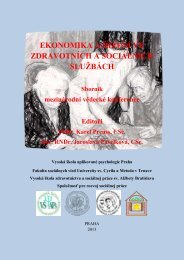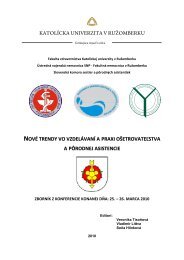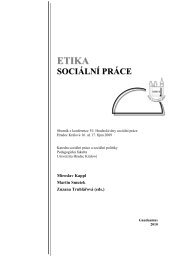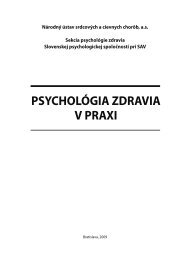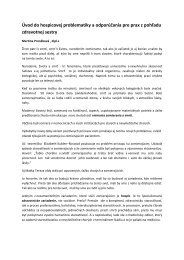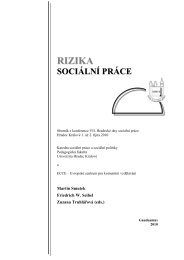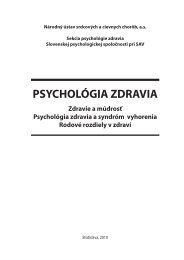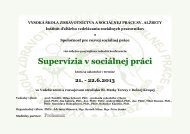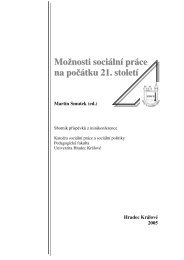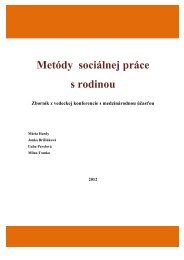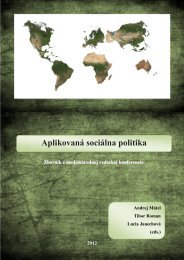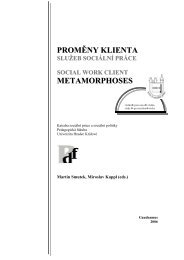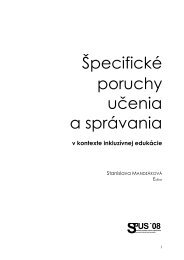Zmena klÃmy â možný dopad (nielen) na obyvateľstvo - Prohuman
Zmena klÃmy â možný dopad (nielen) na obyvateľstvo - Prohuman
Zmena klÃmy â možný dopad (nielen) na obyvateľstvo - Prohuman
Create successful ePaper yourself
Turn your PDF publications into a flip-book with our unique Google optimized e-Paper software.
theories of childhood offer a counterpoint to modernist discourses of childhood<br />
innocence and to the idea that children are intrinsically different from adults (Kelly<br />
and Brooks, 2009; Robinson and Jones Diaz, 2009).<br />
While traditio<strong>na</strong>l theories of child development continue to exert a strong influence<br />
on whether social justice education occurs in early childhood settings<br />
in Ireland at the level of practice, essentialised and deficit perspectives on children’s<br />
capacities are increasingly challenged by the neo-Vygotskian and Brunerian<br />
approaches to children’s learning which have been embedded in curriculum<br />
policy since the 1990s. Bruner’s view that ‘any subject can be taught effectively in<br />
some intellectually honest form to any child at any stage of development’ (Bruner,<br />
1960, p. 33), for example, suggests that rather than seeing global justice issues as<br />
outside of the understanding of young children, educators should work at making<br />
complex ideas accessible in age-appropriate ways. Given the evidence which<br />
suggests that young children are already constructing racialised, discrimi<strong>na</strong>tory<br />
and prejudiced world-views by the time they come to school, there is a strong imperative<br />
towards including global justice education in early childhood contexts<br />
(Ramsey, 2008a; Connolly and Hosken, 2006; Brooker, 2006; Robinson and Jones<br />
Diaz, 2009). Furthermore, existing research in the area of young children’s constructions<br />
of fairness suggests their growing capacity to identify and articulate<br />
perceptions of injustice (Ramsey, 2008a; Ramsey, 2008b; Killen, Breton, Ferguson<br />
and Handler, 1994; Killen and Smeta<strong>na</strong>, 1999; Tisak 1995 cited in Killen et al.,<br />
2001; Theimer et al. 2001 cited in Brown and Bigler, 2005). In an Irish context, the<br />
publication of Aistear: The Early Childhood Curriculum Framework (Natio<strong>na</strong>l<br />
Council for Curriculum and Assessment, 2009), exemplifies this trend towards<br />
recognising and building on children’s capabilities and sig<strong>na</strong>ls the potential for<br />
early childhood education to be a significant site of educatio<strong>na</strong>l change. In putting<br />
in place a rubric for the education of children, from birth to six years, Aistear<br />
offers a road map for developing education programmes for young children. It<br />
acknowledges the changing <strong>na</strong>ture of Irish society and values young children as<br />
citizens who actively engage in their own learning, with others, and in the world<br />
around them.<br />
“Help me to learn to value social and cultural difference and to recognise that<br />
I live in a diverse, multi-ethnic society. Help me to learn to recognise and challenge<br />
injustice and discrimi<strong>na</strong>tion and to stand up for myself and others.” (NCCA,<br />
2009, p. 7)<br />
The Framework challenges educators to integrate a concern for social justice<br />
into their work. It does not suggest staggering children’s learning by starting with<br />
the local and expanding outwards and as such raises the question of the extent to<br />
167




